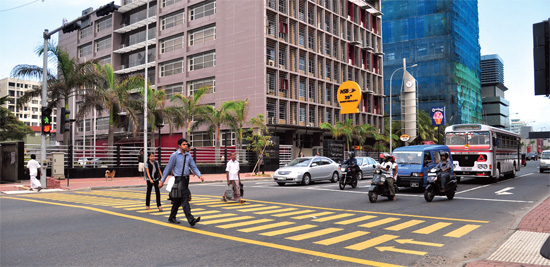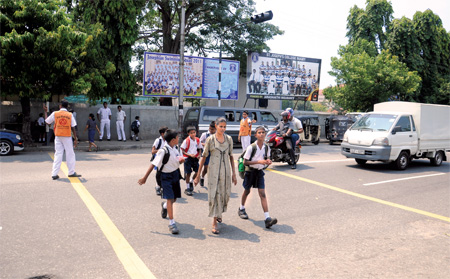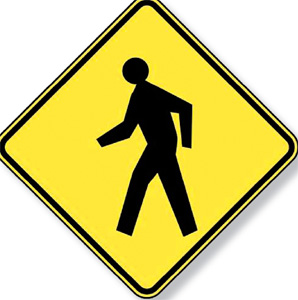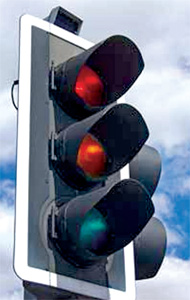The humble pedestrian crossing
 The humble pedestrian crossing might seem a bit dull as far as its
history is concerned. It certainly wasn’t an area that had ever
interested me much before. But a message from a visitor to CBRD in late
2006, enquiring about a “Controlled Traffic Area” experiment somewhere
in London in the 1960s, set me off on a research trail. One thing led to
another and it turns out that the development of the crossings we use
today is quite a fascinating story. The humble pedestrian crossing might seem a bit dull as far as its
history is concerned. It certainly wasn’t an area that had ever
interested me much before. But a message from a visitor to CBRD in late
2006, enquiring about a “Controlled Traffic Area” experiment somewhere
in London in the 1960s, set me off on a research trail. One thing led to
another and it turns out that the development of the crossings we use
today is quite a fascinating story.
The day-to-day grumblings of the people who had to use them and the
people who had to design them are amusing enough on their own, but the
biggest joke is that, for whatever reason, the Men from the Ministry
just couldn’t come to terms with the idea that it could all be as simple
as red, amber and green traffic lights.
The story also contains its fair share of surprises - which I don’t
intend to reveal here - but suffice to say it begins with the creation
of the Zebra Crossing in the 1950s and jumps back and forth in time
thereafter. I’ve stopped at the launch of the familiar Pelican crossing
in 1969 because that, arguably, was the end of real development work,
save for one excursion into lunacy in the early 1980s that it would be
criminal to leave out. More recent ideas like the puffin, toucan and
pegasus aren’t really part of the same story.
To make a crossing more sophisticated than a simple Zebra, we need to
start adding some traffic signals, and the rest of these pages chart the
development of the signal-controlled crossing. Given that the Zebra
emerged
in 1953, and that reports of the introduction of various types of
experimental signalised crossings in the 1960s (of which much more
later) usually portray the public as being baffled by all the new
technology, you could be forgiven for thinking they were a relatively
recent invention. Not so.

Thevery first signalised crossings in Britain were introduced by
Manchester-based Forest City Ltd. in 1929 - and it was very much
recognisable as a pedestrian crossing to modern eyes. It consisted
simply of a regular traffic signal on each side of the road, with a push
button for pedestrians. When the button was pressed the lights changed
to red for a set time, and then returned to green. A timer ensured that
traffic would not be interrupted for a certain interval afterwards.
Perhaps equally remarkable is that the first set of traffic signals was
only installed in Wolverhampton in November 1927 - meaning that in less
than two years, the concept of red-amber-green signals had become
obvious enough to the motorist that Forest City’s marketing need not
explain any part of the traffic signal itself (click the image to the
right to see the brochure for their first prototype). The whole setup
could be manufactured and installed for the towering sum of £65.
Forest City’s plans for the crossing involved painting two parallel
lines across the road to mark the crossing place -’Pedestrian Safety
Zone Lines’ to be precise - and marking another line further back along
with the word
 “STOP” to keep waiting traffic a cautious 20 feet from the crossing.
If £65 was too steep, the 1920s traffic engineer could opt for a
two-light system, with only red and green, or even a one-light system,
with just a red ‘stop’ light that lit up when the button was pressed -
the latter being a much more reasonable £45. It wasn’t long before the
design was modified to include pedestrian signals, though at first these
were simply another set of red, amber and green lights placed at
right-angles to the pavement. “STOP” to keep waiting traffic a cautious 20 feet from the crossing.
If £65 was too steep, the 1920s traffic engineer could opt for a
two-light system, with only red and green, or even a one-light system,
with just a red ‘stop’ light that lit up when the button was pressed -
the latter being a much more reasonable £45. It wasn’t long before the
design was modified to include pedestrian signals, though at first these
were simply another set of red, amber and green lights placed at
right-angles to the pavement.
At the time, with no set procedure, amber always appeared
simultaneously with either the red or green light instead of on its own.
Some of the earliest of these crossings were installed on the A23
London to Brighton road that same year, in response to several serious
accidents involving people trying to cross, including an alderman who
was knockedover and the death of a former councillor. The Evening
Standard announced the “Croydon Experiment” with much fanfare,
announcing with some excitement:
“Croydon is to adopt the remarkable method of enabling pedestrians to
control traffic by means of a push button... The Council has decided to
erect a new type of automatic light signal for pedestrians and traffic
combined.
*************************
Here are some safety tips for pedestrians to follow when crossing
the roads
*Please ensure that you start your journey with sufficient time to
get to your destination, so that you do not have to rush to get into
your van, bus or train.

*Use the pavement at all times and stay away from moving motor
vehicles.There are some inconsiderate motor cyclists and even motor car
drivers who drive on to the pavement to avoid road blocks.
*When crossing the road always use a pedestrian crossing, an overhead
pedestrian bridge, underground crossing and where there is none of these
cross where there is a traffic police officer.
*Always make sure that you do not cross the road near a bend because
motorists coming from your right (or left) will not see you until it is
too late to stop.
*When crossing the road put your hand up to stop the motor vehicle
before crossing the road so as to allow the driver sufficient time to
stop and allow you to cross the road.
*Never cross the road in front of a halted bus or lorry as the
vehicles coming behind will not be able to see that you are crossing the
road.
*Never use a mobile phone while walking and especially when crossing
the road. If you are walking with a small child always ensure that you
hold the child by the hand and that the child is always on the side away
from the road. Always hold the child by the hand when crossing the road.
*When crossing the road please cross briskly at an even pace and do
not walk as if you are having a walk in the moonlight with your loved
ones. Neither should you run across a pedestrian crossing. *Pedestrian
should also be aware that it is an offence to cross the road when there
is a pedestrian crossing within 50 meters.
-Internet |

